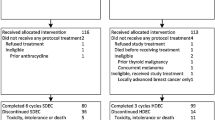Abstract
Chemotherapy is widely used to treat early stage breast cancer (ESBC). Reductions and delays in dose administered—e.g., due to advanced age or febrile neutropenia (FN)—are generally believed to increase risk of disease progression and reduce survival. Little is known about incidence of reduced chemotherapy dose intensity among women with ESBC in the current era of US clinical practice. This study employed a retrospective cohort design and electronic medical records from >65 community oncology/hematology clinics in >35 states (2004–2010). The study population comprised adult women who received myelosuppressive chemotherapy for ESBC (stages I–IIIA). For each such woman, each unique cycle of chemotherapy within their first observed course was identified. Incidence of chemotherapy dose delays (≥7 days for any drug in ≥1 cycles), chemotherapy dose reductions (≥15% for any drug in ≥1 cycles), and low chemotherapy relative dose intensity (RDI <85% over the course) relative to published reference standards were descriptively analyzed for the seven most-frequently planned regimens in the study database. A total of 2,228 women (70% of the subjects who received chemotherapy for ESBC and met other selection criteria) initiated 1 of the 7 most-frequently planned regimens. Mean age of subjects was 54 years and 69% received primary prophylaxis against FN with a colony-stimulating factor. Incidence of dose delays, dose reductions, and low RDI was 31, 24, and 26%, respectively; low RDI typically was due to premature treatment discontinuation. For patients (n = 626) receiving the most common regimen (dose-dense AC-T: doxorubicin/cyclophosphamide, Q2 × 4 cycles, paclitaxel or docetaxel, Q2 × 4 cycles), incidence of dose delays, dose reductions, and low RDI was 42, 29, and 32%, respectively. In the current era of US clinical practice, chemotherapy dose delays and dose reductions are common among women with ESBC receiving frequently used myelosuppressive dose-dense, as well as conventional, chemotherapy regimens.


Similar content being viewed by others
References
National Comprehensive Cancer Network (2011) NCCN clinical practice guidelines in oncology: myeloid growth factors, v1 2011. Available at http://www.nccn.org/professionals/physician_gls/pdf/myeloid_growth.pdf. Accessed 4 Aug 2011
Dang CT (2006) Drug treatments for adjuvant chemotherapy in breast cancer: recent trials and future directions. Expert Rev Anticancer Ther 6:427–436
Lyman GH, Michels SL, Reynolds MW, et al (2010) Risk of mortality in patients with cancer who experience febrile neutropenia. Cancer 116(23):5555–5563
Rajan SS, Lyman GH, Carpenter WR, Stearns SC (2010) Chemotherapy characteristics are important predictors of primary prophylactic CSF administration in older patients with breast cancer. Breast Cancer Res Treat 127(2):511–520
Kuderer NM, Dale DC, Crawford J, Lyman GH (2007) Impact of primary prophylaxis with granulocyte colony-stimulating factor on febrile neutropenia and mortality in adult cancer patients receiving chemotherapy: a systematic review. J Clin Oncol 25:3158–3167
Bonadonna G, Moliterni A, Zambetti M et al (2005) 30 years’ follow up of randomised studies of adjuvant CMF in operable breast cancer: Cohort study. BMJ 330:217
Lyman GH, Dale DC, Crawford J (2003) Incidence and predictors of low dose-intensity in adjuvant breast cancer chemotherapy: a nationwide study of community practices. J Clin Oncol 21:4524–4531
Smith TJ, Khatcheressian J, Lyman GH (2006) 2006 update of recommendations for the use of white blood cell growth factors: an evidence-based clinical practice guideline. J Clin Oncol 24:1–19
Foote MA (1998) The importance of planned dose of chemotherapy on time: do we need to change our clinical practice? Oncologist 3:365–368
Kwak LW, Halpern J, Olshen RA, Horning SJ (1990) Prognostic significance of actual dose intensity in diffuse large-cell lymphoma: results of a tree-structured survival analysis. J Clin Oncol 8:963–977
Lyman GH (2009) Impact of chemotherapy dose intensity on cancer patient outcomes. J Natl Compr Canc Netw 7:88–108
Bonadonna G, Valagussa P, Moliterni A, Zambetti M, Brambilla C (1995) Adjuvant cyclophosphamide, methotrexate, and fluorouracil in node-positive breast cancer: the results of 20 years of follow-up. N Engl J Med 332:901–906
Weycker D, Malin J, Barron R, Edelsberg J, Kartashov A, Oster G (2011) Comparative effectiveness of filgrastim, pegfilgrastim, and sargramostim as prophylaxis against hospitalization for neutropenic complications in cancer chemotherapy patients. Am J Clin Oncol. doi:10.1097/COC.0b013e31820dc075
Weycker D, Malin J, Kim J, Barron R, Edelsberg J, Kartashov A et al (2009) Risk of hospitalization for neutropenic complications of chemotherapy in patients with primary solid tumors receiving pegfilgrastim or filgrastim prophylaxis: a retrospective cohort study. Clin Ther 31(5):1069–1081
Morrison VA, Wong M, Hershman D, Campos LT, Ding B, Malin J (2007) Observational study of the prevalence of febrile neutropenia in patients who received filgrastim or pegfilgrastim associated with 3–4 week chemotherapy regimens in community oncology practices. J Manag Care Pharm 13(4):337–348
Weycker D, Hackett J, Edelsberg JS, Oster G, Glass AG (2006) Are shorter courses of prophylaxis associated with increased risk of hospitalization? Ann Pharmacother 40:402–407
Acknowledgements
Funding for this research was provided by Amgen Inc. to Policy Analysis Inc. (PAI).
Conflict of interest
Derek Weycker, John Edelsberg, and Alex Kartashov are employed by PAI. Gary Lyman is employed by Duke University School of Medicine, Center for Clinical Health Policy Research. Rich Barron is employed by Amgen Inc. Gary H. Lyman is a principal investigator on a research grant to Duke University from Amgen. Amgen Inc. reviewed and approved the study research plan and study manuscript; data management, processing, and analyses were conducted by PAI, and all final analytic decisions were made by study authors.
Author information
Authors and Affiliations
Corresponding author
Rights and permissions
About this article
Cite this article
Weycker, D., Barron, R., Edelsberg, J. et al. Incidence of reduced chemotherapy relative dose intensity among women with early stage breast cancer in US clinical practice. Breast Cancer Res Treat 133, 301–310 (2012). https://doi.org/10.1007/s10549-011-1949-5
Received:
Accepted:
Published:
Issue Date:
DOI: https://doi.org/10.1007/s10549-011-1949-5




